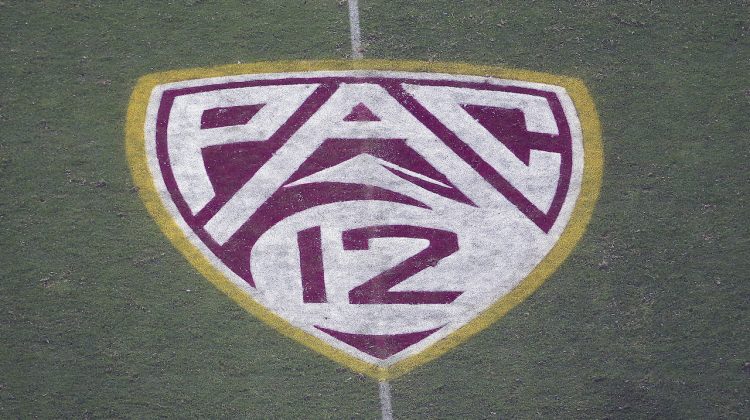The Hotline mailbag publishes each Friday. Send questions to pac12hotline@
Please note: Some questions have been edited for clarity and brevity.
I’ve seen no explanation of the College Football Playoff committee’s decision that No. 8 Oregon should get the honor of playing No. 23 Liberty. The committee started the New Year’s Six bowl lineup with No. 5 vs. No. 6. Why wasn’t No. 7 matched against No. 8 and so on, leaving No. 11 Mississippi to play Liberty? — Mike S
The Pac-12 bowl selection process unfolded exactly as expected, with one exception: Oregon’s opponent in the Fiesta Bowl.
Fans are outraged by the matchup with Liberty. Why aren’t the Ducks facing another Power Five opponent? Why did the Fiesta Bowl stick them with a Group of Five foe?
First of all, the Fiesta Bowl had nothing to do with it. The New Year’s Six assignments are made by the CFP selection committee.
Blame the CFP, not the good folks at the Fiesta.
Before we delve into Liberty specifically, let’s explain the process:
Once the playoff pairing are set, the selection committee places at-large teams into the available New Year’s Six bowls.
— With the Rose and Sugar hosting the semifinals, and with the Orange Bowl under contract for ACC and SEC teams (Florida State vs. Georgia), there were three bowls with slots available: Fiesta, Cotton and Peach.
— Per the selection rules, the committee began with the highest-ranked team and placed everyone in games that made geographic sense: No. 7 Ohio State to the Cotton Bowl (Dallas), then No. 8 Oregon to the Fiesta Bowl (Phoenix), etc.
— However, one of the three bowls is obligated to host the top-ranked team from the Group of Five.
That team was Liberty.
We can debate whether the committee made the right call in ranking 13-0 Liberty, which played the worst schedule in major college football, one spot ahead of 11-2 SMU, which beat a ranked opponent (Tulane) to win the AAC title.
But either way, a Group of Five team would be included in the New Year’s Six pairings — the only unknown was that team’s bowl assignment.
According to sources, the selection committee and the New Year’s Six bowls have an agreement to rotate the Group of Five team on a yearly basis.
The Fiesta Bowl had UCF in the 2018 season and would have hosted Cincinnati in the 2021 season … except the Bearcats jumped out of the New Year’s Six and into the playoff, allowing the Fiesta to match Notre Dame against Oklahoma State.
Last year, the Fiesta was part of the playoff and couldn’t host the Group of Five team.
This was the first chance for the Fiesta to make up for missing the Group of Five team in 2021.
So the selection committee, which aims for fair treatment of all the New Year’s Six games, assigned Power Five teams to the Peach and Cotton and the top-ranked Group of Five team to the Fiesta.
The geography doesn’t make sense for Liberty, which is located in Lynchburg, Va. Were that the primary motivation, the Flames could have been assigned to Atlanta or Dallas.
Instead the committee seemed dead set on rebalancing the Group of Five assignments within the Fiesta, Cotton and Peach Bowls.
In our view, the mistake wasn’t sending the Group of Five team to the Fiesta. It was the committee’s decision to rank Liberty ahead of SMU given the monumental difference in strength-of-schedules and quality wins.
(That decision looks even worse given how the committee treated undefeated Florida State relative to one-loss Alabama.)
Will the game be competitive?
Group of Five teams have beaten Power Five opponents numerous times in New Year’s Six bowls, including Tulane’s victory over USC in the Cotton last season. And the overwhelming majority of the matchups have been extremely competitive.
Anyhow, hope that explains how Oregon got paired with Liberty.
Will the expanded CFP change from six conference champions and six at-large bids to five conference champs and seven at-large bids? From what I’ve read, it has to be unanimous for it to happen before the end of the current contract, so won’t the Pac-2 and Group of Five vote to keep it as is? — @crashlit
The commissioners that make up the CFP’s management committee have recommended the change (from six automatic bids to five) to the CFP’s governing board of university presidents.
We have no reason to believe it won’t be approved despite the presence of Washington State president Kirk Schulz on the board (as the Pac-12’s representative).
There simply isn’t a reasonable case for the winner of the ‘Pac-2’ to receive an automatic bid.
Schulz must work with his fellow presidents and has other priorities — for instance, making sure the Pac-12 receives its share of the CFP revenue in the 2024-25 seasons, the final years of the current media rights contract with ESPN.
Once 2026 arrives, everything could change. The ‘Pac-2’ needs to play the long game.
If it comes to fruition, do you think that the proposal by NCAA president Charlie Baker will end up as a true subdivision split? Or just a further development of the autonomy conference concept under the FBS umbrella? — @AmbitiousCoug
If the approved changes include an education trust fund that requires a minimum investment then, yes, it will be a “true” subdivision.
Nothing creates separation like a financial commitment — and this would be a steep commitment.
Given the size of most athletic departments in the Power Five, the $30,000 per athlete per year stipulation would carry a cost of at least $6 million. Add the NIL piece, and the total expense is likely to zoom into the eight figures.
In our view, Baker’s proposal is more likely to expedite than delay the formation of a super league.
What’s the fate of the Pac-12 Network going to be with the demise of the league? — @MrEd315
In a word: unknown.
The distribution contracts with Comcast, Dish, etc. expire at the end of the 2023-24 competition season, so the Pac-12 Networks as a media company will cease to exist.
However, the infrastructure, technology and production studio are valuable assets.
There are several options, over and above a full dismantling.
For instance, the guts of the networks could be leased or purchased by a media company with sports content to produce (Apple or Amazon come to mind).
Perhaps the networks’ infrastructure will be used to show competitions involving Washington State and Oregon State.
Like so much else about the future of the ‘Pac-2,’ it’s too early to know.
How would the departing schools have fared in their new conferences this year? Who would have done better? The same? Worse? — @draywilson29
My assumption is Washington and Oregon would have been extremely competitive in the Big Ten, with USC and UCLA struggling.
Meanwhile, Arizona would have benefitted the most.
If we play out your scenario across all the conferences, then Texas and Oklahoma would have moved to their new home, the SEC, as well.
And the Wildcats finished the season ranked higher by the selection committee than any of the remaining schools in the Big 12.
The Big 12 had four teams in the final top-25: No. 3 Texas and No. 12 Oklahoma, which are leaving, and No. 20 Oklahoma State and No. 25 Kansas State, which are staying.
The Wildcats were No. 14.
Do you see Florida State’s snub by the CFP as an indication that the committee views the ACC as an inferior conference to the SEC, Big Ten and Big 12? — @BigTank473
I’m not sure there is any sort of deliberate, conscious conference bias, but let’s not kid ourselves: The SEC is treated differently due to its dominance of the playoff era.
In our view, the situation came down to the following: Once Alabama beat Georgia, the Crimson Tide was getting in — there was zero chance of a one-loss SEC champion being left out.
And because of the head-to-head result, Alabama’s inclusion meant Texas had to make the cut, as well.
As we’ve noted several times, the system is flawed with five conference champions for four spots. If the Pac-12 had produced a playoff-worthy team for the majority of the CFP era, there would have been more controversies of this nature.
In fact, the only other year there was a real issue, in 2014, the Pac-12 had a champion (Oregon) that was clearly good enough to make the cut.
Do you have any insight on Washington coach Kalen DeBoer’s contract extension? — @Cargoman0363
I have been told by a source that the Huskies and DeBoer are “close” to a deal that will pay the second-year coach in excess of $8 million annually.
If nothing is finalized by the Sugar Bowl, there will be reason to wonder if DeBoer is waiting out other jobs (hello, Michigan) — either because he wants to leave UW or use them as leverage to push the annual compensation closer to $10 million.
If Oregon State and Washington State eventually merge with the Mountain West to become a new Pac-12, would that group maintain Power Five status? — @WHS1969
The Hotline views that outcome as unlikely, but let’s be clear on the categorization: The term ‘Power Five’ is part of the College Football Playoff lexicon; it’s not an NCAA governance term.
We suspect the Big Ten, Big 12, ACC and SEC will vote to have the Pac-12 removed from the power conference tier, which would impact playoff revenue but not access.
The expanded event will have five automatic bids in a sport with four power conferences. The highest-ranked champion from the Group of Five (or Group of Six, as the case may be) will have a guaranteed berth waiting for it.
Please list your top-five favorite moments in Pac-12 football history. — @kmasterman
I’m not in position to provide an insightful answer — that would require some deep thought, in addition to a reasonable timeframe.
Do you mean just the Pac-12 era, with Colorado and Utah? Or the history of the conference since I began reporting (in the previous century)?
The Hotline will endeavor to provide a comprehensive list after the bowl season, but I’ll say this:
It would be tough for anything to eclipse the 2004 postseason controversy in which Cal was boxed out of a spot in the Rose Bowl — by Texas — thanks to BCS politics.
We’ll never forget Longhorns coach Mack Brown lobbying hard for his team while his brother, Watson, and others, cast secret ballots in the Coaches’ top-25 poll.
(The final ballots are made public these days, providing some accountability. Back then, they weren’t.)
Despite winning its final game, Cal lost enough votes as the result of the politicking to fall out of the Rose Bowl.
*** Send suggestions, comments and tips (confidentiality guaranteed) to pac12hotline@bayareanewsgroup.
*** Follow me on Twitter: @WilnerHotline
*** Pac-12 Hotline is not endorsed or sponsored by the Pac-12 Conference, and the views expressed herein do not necessarily reflect the views of the Conference.
Related posts:

(AP Photo/Ralph Freso, File)
Business of Sports – Pac-12 future revenues could be half those of the SEC by the end of the 2020s Pac-12 power ratings: Oregon on top, as Stanford and ASU race to the bottom, 0-18 looms
Pac-12 power ratings: Oregon on top, as Stanford and ASU race to the bottom, 0-18 looms

(AP Photo/Ralph Freso, File)
Wilner – And Utah makes 10: How every departing Pac-12 school drove a knife into the conference
AP Photo/Godofredo A. Vásquez)
Wilner – Future arrives for Cal and Stanford as ACC releases the 2024-30 football schedule rotation
